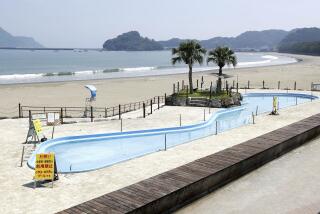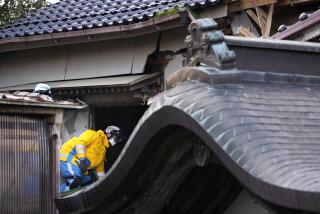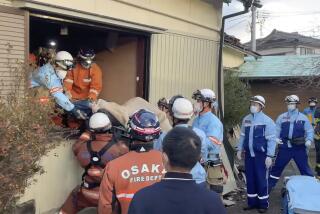Japan’s toll of dead and missing surpasses 15,000; 380,000 displaced
The Japanese economy is showing increasing signs of disarray, with the world’s third-largest economy struggling with shortages of fuel, questions of food safety, and scarce electricity supplies that are forcing stores and restaurants in Tokyo to close early.
The problems come as the toll of the missing and dead rose above 15,000, the National Police Agency said, according to Kyodo News Agency. The toll included nearly 5,700 deaths and 9,500 missing.
Quoting police, the news agency said 380,000 people had been dislocated, and were staying in 2,000 shelters.
Fuel is so scarce that even trucks and ambulances have been idled in the nation’s tsunami-scarred northeast, NHK television reported. Refugees chased from homes by the mud had to brave subfreezing weather overnight, as temperatures dipped to as low as 21 degrees Fahrenheit in the rural northern section of Honshu island. Officials were trying to route kerosene to shelters that have no heating, NHK said, and the government is trying to move gasoline supplies from western Japan to the north, Kyodo reported.
Related: Isolated and angry amid Fukushima nuclear crisis.
Authorities were still slowly making their way to towns to resupply hospitals. But the reality was grim. At one hospital south of Kesennuma in Miyagi prefecture, the first floor was still caked in mud, destroying medical records and equipment, NHK reported. The hospital was running on power generators, and was still short on critical medicine. The lone doctor working at the hospital on Thursday told the TV network he had been working nonstop since the 9.0 quake hit a week ago.
The threat of power shortages forced the normally bright neighborhoods of Ginza and Shibuya in Tokyo to dim their lights, NHK reported, which helped the city avoid widespread rolling blackouts. Restaurants and stores closed earlier than normal.
And the power shortages also caused some train operators to run fewer trains, which were much slower than normal.
NHK was also reporting Friday morning that a week after the earthquake, emergency crews are still having difficulty reaching some areas hit by the tsunami. In some situations, a crew might have enough fuel to reach their destination, but would not have enough to return home to get more supplies, NHK reported.
Gasoline has been stolen in eight locations in emergency storage areas at elementary schools, NHK reported.
Japanese officials began ordering that food be tested for radioactivity, Kyodo News Agency reported, although no food has exceeded a provisional standard set up by the government. U.S. officials also planned to monitor food shipments from Japan for radiation.
In Singapore, Japanese restaurants were reporting shortages of fresh seafood from Japan, and in Japan, domestic production of ethylene, an ingredient in plastic bottles and medical products, was cut by 25%, Kyodo reported.
Another big problem was the strengthening of the yen to a record post-World War II high of 76.25 yen to $1, wire service reports said. The strengthening of the yen will make it more costly for U.S. consumers to buy Japanese goods, including popular cars like the Toyota Prius and Honda Fit.
“We cannot bear this,” Toshiyuki Shiga, chairman of the Japan Automobile Manufacturers Assn., was quoted as saying by Kyodo News Agency.
More to Read
Sign up for Essential California
The most important California stories and recommendations in your inbox every morning.
You may occasionally receive promotional content from the Los Angeles Times.











